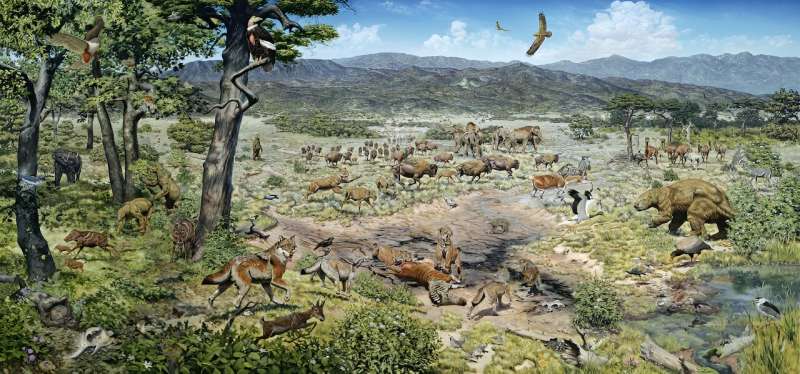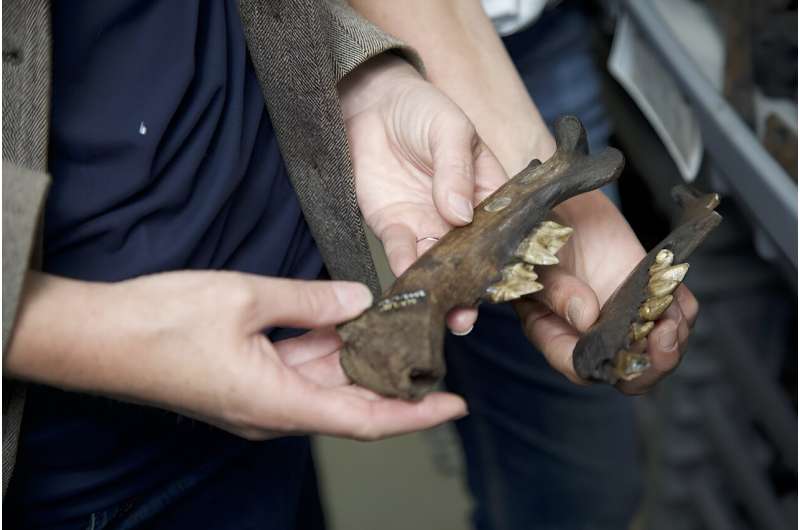This article has been reviewed according to Science X's editorial process and policies. Editors have highlighted the following attributes while ensuring the content's credibility:
fact-checked
trusted source
written by researcher(s)
proofread
Study: Changing climate, growing human populations and widespread fires contributed to the last major extinction event

Over the past decade, deadly wildfires have become increasingly common because of both human-caused climate change and disruptive land management practices. Southern California, where the three of us live and work, has been hit especially hard.
Southern California also experienced a wave of wildfires 13,000 years ago. These fires permanently transformed the region's vegetation and contributed to Earth's largest extinction in more than 60 million years.
As paleontologists, we have a unique perspective on the long-term causes and consequences of environmental changes, both those linked to natural climate fluctuations and those wrought by humans.
In a new study, published in August 2023, we sought to understand changes that were happening in California during the last major extinction event at the end of the Pleistocene, a time period known as the Ice Age. This event wiped out most of Earth's large mammals between about 10,000 and 50,000 years ago. This was a time marked by dramatic climate upheavals and rapidly spreading human populations.
The last major extinction
Scientists often call the past 66 million years of Earth's history the Age of Mammals. During this time, our furry relatives took advantage of the extinction of the dinosaurs to become the dominant animals on the planet.
During the Pleistocene, Eurasia and the Americas teemed with enormous beasts like wooly mammoths, giant bears and dire wolves. Two species of camels, three species of ground sloths and five species of large cats roamed what is now Los Angeles.
Then, abruptly, they were gone. All over the world, the large mammals that had characterized global ecosystems for tens of millions of years disappeared. North America lost more than 70% of mammals weighing more than 97 pounds (44 kilograms). South America lost more than 80%, Australia nearly 90%. Only Africa, Antarctica and a few remote islands retain what could be considered "natural" animal communities today.
The reason for these extinctions remains obscure. For decades, paleontologists and archaeologists have debated potential causes. What has befuddled scientists is not that there are no obvious culprits but that there are too many.
As the last ice age ended, a warming climate led to altered weather patterns and the reorganization of plant communities. At the same time, human populations were rapidly increasing and spreading around the globe.
Either or both of these processes could be implicated in the extinction event. But the fossil record of any region is usually too sparse to know exactly when large mammal species disappeared from different regions. This makes it difficult to determine whether habitat loss, resource scarcity, natural disasters, human hunting or some combination of these factors is to blame.
A deadly combination
Some records offer clues. La Brea Tar Pits in Los Angeles, the world's richest ice age fossil site, preserves the bones of thousands of large mammals that were trapped in viscous asphalt seeps over the past 60,000 years. Proteins in these bones can be precisely dated using radioactive carbon, giving scientists unprecedented insight into an ancient ecosystem and an opportunity to illuminate the timing—and causes—of its collapse.

Our recent study from La Brea Tar Pits and nearby Lake Elsinore has unearthed evidence of a dramatic event 13,000 years ago that permanently transformed Southern California's vegetation and caused the disappearance of La Brea's iconic mega-mammals.
Sediment archives from the lake's bottom and archaeological records provide evidence of a deadly combination—a warming climate punctuated by decadeslong droughts and rapidly rising human populations. These factors pushed the Southern California ecosystem to a tipping point.
Similar combinations of climate warming and human impacts have been blamed for ice age extinctions elsewhere, but our study found something new. The catalyst for this dramatic transformation seems to have been an unprecedented increase in wildfires, which were probably set by humans.
The processes that led to this collapse are familiar today. As California warmed coming out of the last ice age, the landscape became drier and forests receded. At La Brea, herbivore populations declined, probably from a combination of human hunting and habitat loss. Species associated with trees, like camels, disappeared entirely.
In the millennium leading up to the extinction, mean annual temperatures in the region rose 10 degrees Farenheit (5.5 degrees Celsius), and the lake began evaporating. Then, 13,200 years ago, the ecosystem entered a 200-year-long drought. Half of the remaining trees died. With fewer large herbivores to eat it, dead vegetation built up on the landscape.
At the same time, human populations began expanding across North America. And as they spread, people brought with them a powerful new tool—fire.
Humans and our ancestors have used fire for hundreds of thousands of years, but fire has different impacts in different ecosystems. Charcoal records from Lake Elsinore reveal that before humans, fire activity was low in coastal Southern California. But 13,200 to 13,000 years ago, as human populations grew, fire in the region increased by an order of magnitude.
Our research suggests that the combination of heat, drought, herbivore loss and human-set fires had pushed this system to a tipping point. At the end of this period, Southern California was covered in chaparral plants, which thrive after fires. A new fire regime had become established, and the iconic La Brea megafauna had disappeared.
Lessons for the future
Studying the causes and consequences of the Pleistocene extinctions in California can provide valuable context for understanding today's climate and biodiversity crises. A similar combination of climate warming, expanding human populations, biodiversity loss and human-ignited fires that characterized the ice age extinction interval in Southern California are playing out again today.
The alarming difference is that temperatures today are rising 10 times faster than they did at the end of the ice age, primarily because of the burning of fossil fuels. This human-caused climate change has contributed to a fivefold increase in fire frequency and intensity and the amount of area burned in the state of California in the past 45 years.
While California is now famous for extreme fires, our study reveals that fire is a relatively new phenomenon in this region. In the 20,000 years leading up to the extinction, the Lake Elsinore record shows very low incidence of any fire even during comparable periods of drought. Only after human arrival does fire become a regular part of the ecosystem.
Even today, downed power lines, campfires and other human activities start over 90% of wildfires in coastal California.
The parallels between the late Pleistocene megafaunal extinctions and today's environmental crises are striking. The past teaches us that the ecosystems we depend upon are vulnerable to collapse when stressed by multiple intersecting pressures. Redoubling efforts to eliminate greenhouse gas emissions, prevent reckless fire ignitions and preserve Earth's remaining megafauna can help avert another, even more catastrophic transformation.
Provided by The Conversation
This article is republished from The Conversation under a Creative Commons license. Read the original article.![]()


















